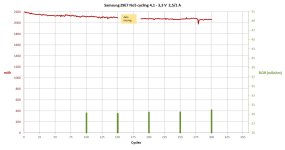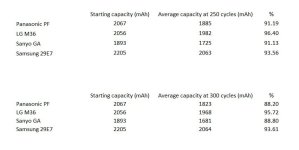eMark said:Docware's reply provided the means to answering john's two questions.docware said:Hopefully I am not annoying too much, if I again recommend to consider Pajda´s posts as a required reading. Just open some text editor and with ctrl C / ctrl V do your own Reader´s Digest.
The quantity of needed separated cycle-life tests starts in my opinion at number 3 or 4 at least, ending somewhere at ….. ?
For the sake of discussion let's assume a pack with 3000mAh 10A cells can be charged and discharged at least 100 times at it's 10A rating from 4.1V to 3.3V. Furthermore we'll assume it can be charged 500 times to 4.1V with a 2.5 amp charger (.83C) with worthwhile useable energy for 500 cycles.
So for the sake of discussion we'll assume you can charge the pack 500 times at .83C (2.5A) and discharge it 500 times at .83C (2.5A) over three years of occasional easy-going ebiking without any noticeable voltage sag. So, following that ultra simplistic TLC logic if you want at least 500 charge/discharge cycles over three years don't discharge the cells at more than .83C. Using that KIS logic it's possible to get at least 500 charge/discharge cycles from either a: VTC6, HG2, 30Q, PanasonicPF, SanyoGA and almost any 8P14S 18650 pack and possibly a hundred more cycles :thumb:
Now for those that contend this post is not practical and is derailing the thread then is this thread purely hypothetical bench testing that may not even apply to a real-life daily ebiking commuting routine?
The problem with my scenario is that you can't go 40 or 30 mph on your ebike if you want to get at least 500 cycles. According to Dak77 it's not possible to get 500 cycles with a daily commuting ebike routine using say, 3450mAh 5A LG Chem M36 cells or any other 18650 cell pack (eg. 8P14S) ... unless you're only going 25mph with a fair amount of pedaling and even then 500 charge/discharge cycles may be pushing it according to Dak77 ??
I think you misunderstood what I was saying. I have no idea if it's possible to get 500 cycles using an M36 at high loads. In your 8p configuration , I would bet that it will based on testing posted here, if your maximum current drain is less than 30 amps total . It seems more likely the M29 will fit that role better though. That's more for someone like Doc/Flippy/Padja to say. What I meant was, by the time you wear down a high discharge cell , "most" people would be ready to upgrade to a newer cell or chemistry , whichever. If you can get 3 years use out of a cell that can handle full throttle smashing with little sag, it makes more sense to go that route than to build a monster sized pack so you can keep it for 1000 charges, in which it will die of old age long before it dies from charge/discharge cycles. This point of view is only from someone that rides recreationally rather than for transportation every day.



